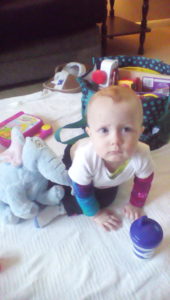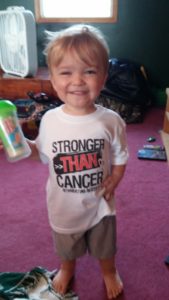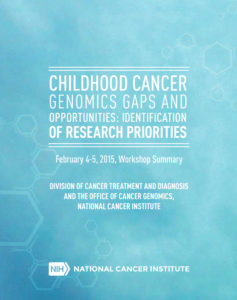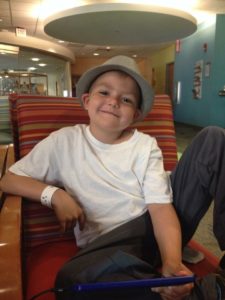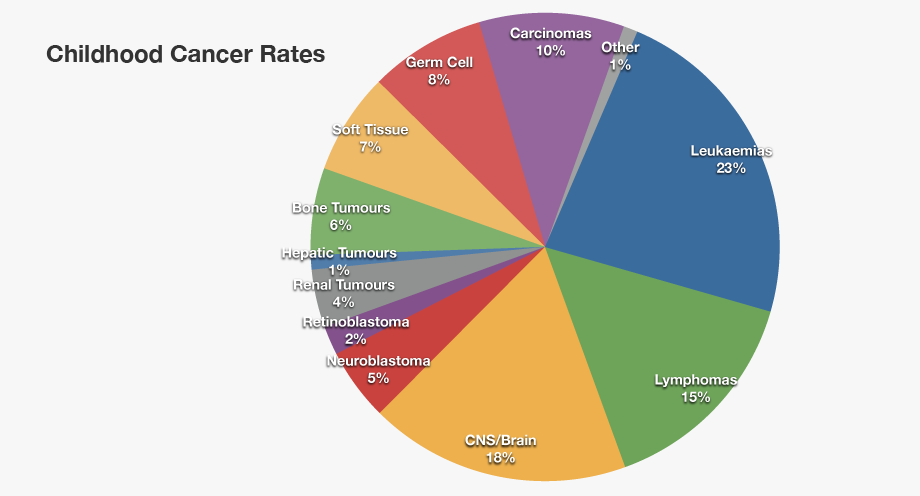“Reason this person is a Gold Ribbon Hero: Kylee was just 10 months when diagnosed with ALL Leukemia and has been undergoing treatment since August 27th 2014 . It has been heart wrenching to watch her and her parents go through this but this one little girl has touched the lives of so many with her smile. She has taught the whole family how to come together for a cause that is bigger than all of us. She is and will always be my little hero.” – Tracy C
Monthly Archives: July 2015
Gold Ribbon Hero Kylee D
Gold Ribbon Hero Clayton E
“Reason this person is a Gold Ribbon Hero: Clayton is 21 months old and is fighting Retinoblastoma, a rare type of eye cancer found in children. He was diagnosed with this disease on June 18th and on June 24th had surgery to remove his right eye due to the size and severity of the tumor. Clayton has recently had another procedure to have a port placed in his chest to begin chemotherapy on July 22nd. Throughout all the procedures and painful testing, Clayton has remained our happy, loving, smiling, energetic little boy. He amazes me everyday! He has definitely made this whole nightmare much easier for us, his family, to handle. He makes us stronger and is our little hero!” – Jessica E
CHILDHOOD CANCER GENOMICS GAPS AND OPPORTUNITIES: IDENTIFICATION OF RESEARCH PRIORITIES
February 4-5, 2015, Workshop Summary
DIVISION OF CANCER TREATMENT AND DIAGNOSIS AND THE OFFICE OF CANCER GENOMICS, NATIONAL CANCER INSTITUTE
For more information about the American Childhood Cancer Organization call 855.858.2226 or visit:
Gold Ribbon Hero Kayden H
“Reason this person is a Gold Ribbon Hero: Kayden is my 4 yr old grandson who was diagnosed with cancer about 6 months ago and the chemo really gets him down but through the pain he still smiles and tells u I love you Mimi to the moon and back.This little guy is my HERO!!!!” – Christina B
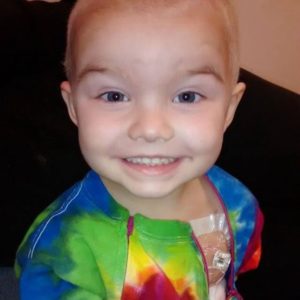
Gold Ribbon Hero Jordan B
“Reason this person is a Gold Ribbon Hero: Jordan is an extraordinary child. After being diagnosed with ALL, his first question was “Am I going to die”, my immediate response was “no baby, God will see you through this”. Jordan has been in great spirits since that day. Despite taking all the medications and hating to take them, he does it because he knows one day it will all be over. He tells everyone he has cancer but he’s doing good. Even with his hair loss, he never cried, he showed everyone with pride! He is now 7 years old and is in the Maintenance phase, his hair has grown back, and he has more personality than before. His compassion for others has grown since his diagnosis. He has been so strong and grown up about this entire process that he even amazes his doctors and nurses. He doesn’t complain about his procedures, although, he does try to rush the doctors and nurses so he can get back home, all he has ever said is “mommy, I’ll be glad when I beat cancer and my port can come out”. He is truly a fighting champion and so deserving of this nomination.” – Brianna B
Gold Ribbon Hero Kendyl F
“Reason this person is a Gold Ribbon Hero: KENDYL has the biggest heart. She is a 14 year neroblastoma survivor. She was 14 months old when the doctors found her tumor. And she had been a fighter ever since. She gives a 100 percent at whatever she does. She doesn’t give up. She wants to help everyone around her. KENDYL Has Been Our Relay FOR Life Captain FOR 13 years. SHE RAISES MONEY to find a cure for cancer, so her children will not have to go through what she went through. The doctors told me that she might not walk, boy was they wrong. Kendyl is the goalie of her soccer team. She puts her whole heart in protecting that goal. Just like she does with everything that comes her way. I think we’ll I know she will be a great gold ribbon hero, because she us truly a hero to so many people.” – Stephanie F
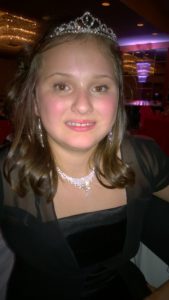
Gold Ribbon Hero Trey L
“Reason this person is a Gold Ribbon Hero: Trey’s parents, Mike and Missy Love, were told when he was 4 and had a stroke that the neuroblastoma was back and they should begin to say goodbye to their son. He will be 9 this October and has touched the lives of so many in our area. He has shown us that miracles do happen, but also that we need to be the voice for the children fighting this demon. His dad Mike Love, wrote a great book about the superhero Trey, it is called The Adventures of Chemo Kid. He literally Never Gives Up!” – Kelli-Ann A.
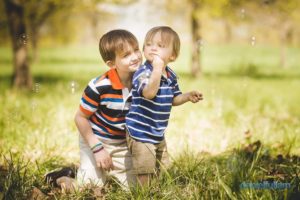
More about Childhood Neuroblastoma Cancers:
- About Childhood Neuroblastoma Cancer – Detection and Diagnosis
- Causes, Risk Factors, and Prevention of Childhood Neuroblastoma Cancer
- What are the signs and symptoms of Childhood Neuroblastoma Cancer?
- Childhood Neuroblastoma Cancer Treatment
- Childhood Neuroblastoma Cancer – Stages and Prognosis
- What is the expected life span of Childhood Neuroblastoma Cancer?
- After Treatment – Living as a Childhood Neuroblastoma Cancer Survivor
Learn More About the Different Types of Childhood Cancers:
- Childhood Brain Tumor Cancer (Brain Stem Tumors)
- Spinal Cord Tumor Cancer
- Childhood Neuroblastoma Cancers
- Childhood Hodgkin Lymphoma Cancers
- Non-Hodgkin Lymphoma Cancers
- Wilms tumor (Kidney Tumors)
- Rhabdomyosarcoma
- Retinoblastoma
- Bone cancer (including osteosarcoma and Ewing sarcoma)
- Leukemia Cancers: Acute lymphocytic (lymphoblastic) leukemia (ALL) Acute myelogenous leukemia (AML); Juvenile myelomonocytic leukemia (JMML)
- Hepatoblastoma (Liver Cancer)
- Rhabdoid Tumors
Gold Ribbon Hero Kelly K
“Reason this person is a Gold Ribbon Hero: Ms. Kelly has been our son’s oncology nurse practitioner since the day he was air lifted to Comers Childrens Hospital with an inoperable brain tumor. Kelly called often to check in Daniel during his treatment and thru his brain surgeries. Kelly knew exactly how to reassure Daniel when we couldn’t. She spent quite a bit of time with us explains to us procedures, side effects and mire. She helped us find the words to tell our son he had cancer. She was and continues to be a source of strength and courage for our family. Kelly has a fun, loving attitude that helps her relate to children. We are so blessed to be on this journey with Kelly Krammer.” – Karen A
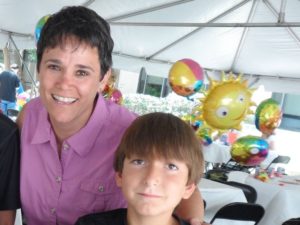
Children Diagnosed With Cancer: Dealing with Diagnosis
Dealing with a Cancer Diagnosis
 In the briefest space of time, in the time it takes to say just four little words, the normal, hectic, everyday life of a family can so easily be turned upside down. Hearing those four words that every parent dreads–“Your child has cancer”–is a life-altering experience, and indeed not just for parents, but for siblings, relatives, and even friends. The normal daily routine of the family changes overnight as families cope with the diagnosis, educate themselves on the best treatment options, comfort and care for their sick, scared child while still working, providing for their family, and trying to maintain a semblance of normalcy for siblings.
In the briefest space of time, in the time it takes to say just four little words, the normal, hectic, everyday life of a family can so easily be turned upside down. Hearing those four words that every parent dreads–“Your child has cancer”–is a life-altering experience, and indeed not just for parents, but for siblings, relatives, and even friends. The normal daily routine of the family changes overnight as families cope with the diagnosis, educate themselves on the best treatment options, comfort and care for their sick, scared child while still working, providing for their family, and trying to maintain a semblance of normalcy for siblings.
Handling all of the dramatic changes that a cancer diagnosis requires needs support. Most of this support comes from family members and friends who can supply meals, care for other siblings, transportation, and emotional support. At the ACCO, we are dedicated to offering support as well. We understand just how traumatic a diagnosis of childhood cancer is, and our resources are geared towards helping families navigate this difficult time armed with the information they need to make the right choices for their child and with tools to give their children comfort and succor as they face treatment.
Detailed information from hospitals
The biggest challenge facing parents of a childhood cancer warrior is often getting the right information in a timely fashion, so they can make informed choices about treatment. The first avenue of information is usually the oncologists and physicians, who can provide detailed information about the cancer diagnosis as well as the appropriate treatment options. They will help parents navigate the often-overwhelming amount of information on the cancer itself, the different treatment protocols available today, and short-term and long-term effects of each treatment. Unfortunately, the process of absorbing all of this information, processing it, and knowing what questions to ask can be extremely difficult. Parents often need to make a number of difficult decisions quickly, signing consent and treatment forms, and making crucial decisions about the best way forward for their child while still processing the initial diagnosis.
The ACCO offers support as well. We have an extensive on-line library of information dedicated to all forms of childhood cancers, designed to help parents find the information they need when they need it. We also provide information on current treatment protocols and available treatment drugs, as well as details on how to become involved with clinical trials that may provide a cutting-edge treatment option. With our free informational resources and wealth of experience, we hope to offer parents access to critical information they need to make critical decisions and give their children the best possible chance of fighting–and beating–this diagnosis.
Dealing with emotions
After receiving a diagnosis of childhood cancer, everything seems to happen within a very short span of time, piling even more stress into an already traumatic and difficult situation. The hours and days after after the diagnosis can seem like a bad dream or an emotional roller coaster. All parents whose children are diagnosed with childhood cancer experience some level of stress and emotional pain, but of course every individual and every family handles this experience differently depending on their cultural background, experiences in their lives, and their personal coping styles. Childhood cancer in the family can be a great shock and the beginning of a testing time for the parents.
The ACCO was founded by a group of parents who have experienced this storm themselves, so they understand how difficult it can be to deal with a cancer diagnosis. Our extensive resources, offered for free to families facing this crisis, are designed to provide families with all the necessary support, advice, and guidance they need to help their families survive and prosper while battling this dreaded disease. From informational books and newsletters, to materials designed to offer aid and comfort and make the treatment more comfortable and understandable for children, to on-line support groups composed of parents going through the exact same thing, our goal is to help families know that they are not alone and that we are here to help!
For more information about the American Childhood Cancer Organization call 855.858.2226 or visit:
Cancer in Children
When we hear the word “cancer”, most of us immediately think of adult cancers, the ones at the center of glamorous media campaigns, well-publicized fundraising drives, and focused research efforts, such as breast cancer, colon cancer, prostate cancer, lung cancer, just to name a few. When we hear the words “childhood cancer”, most of us probably think of those same cancers, just in miniature, and assume they have the same causes and the same treatment protocols. In fact, childhood cancers are very, very different than adult cancers, and require very different, specialized treatments.
“Childhood cancer” is a general term describing more than 12 different types of cancer, each of which has numerous sub-types, and each of which requires precise treatment protocols tailored to the small, still-developing bodies of children. The American Childhood Cancer Organization is dedicated to raising awareness about the unique challenges presented by childhood cancer, and the desperate need for new and better treatment protocols that will target these dangerous cancers without the permanent and disabling late term effects that are the all-too-common result of treating childhood cancers with drugs developed to cure adult cancers. We encourage you to read about these most common forms of childhood cancer below, and support the ACCO in its mission to improve the lives of children facing this dreaded disease.
Childhood Leukemia
Leukemia is the most common form of childhood cancer, covering more than 30% of all childhood cancers. Leukemia originates in the soft inner part of the bone—the marrow—which is responsible for the development of blood cells. It usually affects the development of white blood cells that are responsible for fighting infection, compromising the body’s ability to fend off disease and heal itself, but leukemia can develop in other types of blood cells as well. The two most common forms of leukemia in children are Acute Lymphocytic Leukemia (ALL) and Acute Myelogenous Leukemia (AML). The good news is that treatments for childhood leukemia have greatly improved in the past decade, and the five-year survival rate is now over 85% for ALL, and over 70% for AML.
Central nervous system and brain tumors
This is the second most widely seen cancer in kids, making up approximately 26% of all childhood cancers. There are several categories of brain tumors and the treatment and prognosis of each of the type is different, depending on a variety of factors including where the tumor is located, the areas of the brain and/or nervous system it is affecting, and how quickly it is growing. It has been observed that children who suffer from such cancer tend to develop tumors in the lower portion of their brain, such as the cerebellum, or the spinal column. Such tumors can cause trouble with object handling, dizziness, blurred vision, vomiting, nausea and headaches.
Neuroblastoma
This type of childhood cancer starts in nerve cells inside a developing fetus or embryo, and grows into tumors in nerve clusters. While neuroblastoma can develop in any part of the body, it is most commonly found in the abdomen. It is by far the most common form of cancer in infants, and is usually diagnosed between the ages of 1 and 2, although can be diagnosed in children as old as 10. Unfortunately, early diagnosis is very difficult, and in 2 out of 3 cases, the disease has already spread to the lymph nodes by the time of diagnosis.
Wilms Tumor
Wilms Tumor develops in or near one or both kidneys, and may even begin developing while the children is still in the womb. It is usually diagnosed in children between the ages of 3 and 4 years old, and is rarely seen in kids above 6 years old. It usually shows as a lump or swelling in the abdomen. The child may often have other symptoms such as poor appetite, nausea, pain, and fever. Wilms Tumor contributes to about 5% of cancers in children.
Bone cancers
Bone cancers in children usually fall into one of two main groups. The most common form—Osteosarcoma—develops in the bones around the knees or near the ends of the long bones of the legs, although it does occasionally occur in the arm bone near the shoulder, the hip bone, or even the jaw. Ewing sarcoma (Ewing family of tumors) is a less common form of bone cancer, usually forming in the pelvis, the chest wall (ribs and shoulder blades), or the middle of the long bones of the leg. While both forms of bone cancer are most commonly diagnosed in teenagers and older children, they can be found in younger children as well. There are some commonalities between these two types of bone cancer, but they respond differently to current treatment protocols.
If you are interested in learning more about these or other forms of childhood cancer, if you would like to know more about the critical need for additional research into the causes and appropriate treatments for childhood cancer, or you would like to support the ACCO’s mission to support all children coping with cancer or its long-term effects and their families, we encourage you to visit www.acco.org to find out how you can help!
For more information about the American Childhood Cancer Organization call 855.858.2226 or visit:



